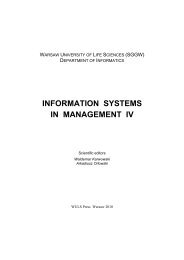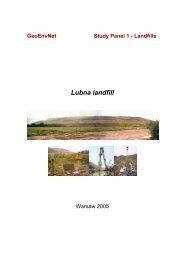ACTA SCIENTIARUM POLONORUM - SGGW
ACTA SCIENTIARUM POLONORUM - SGGW
ACTA SCIENTIARUM POLONORUM - SGGW
You also want an ePaper? Increase the reach of your titles
YUMPU automatically turns print PDFs into web optimized ePapers that Google loves.
Oeconomia 10 (1) 2011, 57–68ECONOMIC POLICY IN CENTRAL EASTERN EUROPE:UNIT ROOT CONSEQUENCESLukas Mazal, Kevin J. RowlesUniversity of Huddersfield, UKAbstract. This article aims to provide an econometric justification for economic policy inthe Central and Eastern European area by examining the stability of real GDP and industrialproduction in the Czech Republic, Slovakia, Poland, and Hungary. Stability of GDP andindustrial production is examined by unit root tests. The Dickey-Fuller (1979) unit roottest indicates unit root in case of all four outputs. In case of the industrial production, theresults are mixed. Nonetheless, difference stationarity of the GDP implies that there is nodeterministic time trend in GDP. Therefore, there is no short-run trend reversion. Deep andlong recessions are not only possible but also even likely. Thus, actions of economic policycan be regarded as justified because they are desirable to boost economy in order to reversethese recessions. This study can also be regarded as an extension of unit root tests to thepost communist countries.Key words: Central Eastern Europe, Classical Economics, Keynesianism, Stability of output,Unit rootINTRODUCTIONThe end of the Second World War in 1945 marked the beginning of more than fortyyears during which the European continent was divided by the ‘Iron Curtain’ and the twoparts progressed along different paths. Politically, economically, socially, and culturally,there seemed to be little to unite the divided Europe. However, in one area at least thereappeared to be a common development, namely the emergence of the state as the majoreconomic decision-maker in society. In Central Europe, the role of the state was determinedby socialist principles. Socialism required the state to own the means of productionand this would enable the authorities to develop the system of central planning. Withina few years of the emergence of Soviet hegemony, the socialist states had appropriatedthe means of production. There were some exceptions such as the development of Polishagriculture outside the collectives and limited private enterprise was tolerated in Hungaryafter the 1960s.Corresponding author – Adres do korespondencji: Lukas Mazal, e-mail: lucas.mazal@googlemail.com; Kevin J. Rowles, k.j.rowles@hud.ac.uk
















